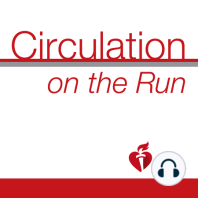18 min listen
Circulation August 4, 2020 Issue
ratings:
Length:
21 minutes
Released:
Aug 3, 2020
Format:
Podcast episode
Description
Dr Carolyn Lam: Welcome to Circulation on the Run, your weekly podcast summary and backstage pass to the journal and its editors. I'm Dr Carolyn Lam, associate editor from the National Heart Center and Duke National University of Singapore. Dr Greg Hundley: And I'm Dr Greg Hundley from VCU Health, the Pauley Heart Center in Richmond, Virginia. Dr Carolyn Lam: Our feature paper today is very important and pertinent to the times, talking about the multi-system inflammatory syndrome in children in our current global SARS coronavirus 2 pandemic. Really, really important stuff, but you have to hold on, listen with us to this summary which is full of really exciting papers. You know what, Greg? I'm going to start. So what do you know about the rostral medial prefrontal cortex of our brains? Dr Greg Hundley: Well, let's see. I wonder if it has anything to do with emotion or stress maybe? Dr Carolyn Lam: Oh, you're too smart. Either that or that coffee is loaded. Very good answer. The rostral medial prefrontal cortex is an important brain region that processes stress and regulates immune and autonomic functions. Now, since psychological stress is a risk factor for major adverse cardiovascular events in individuals with coronary artery disease, our authors today, Dr Shah and colleagues from Rollins School of Public Health, Emory University, hypothesize that changes in the rostral medial prefrontal cortex activity with emotional stress may be informative for future risk of MACE or major adverse cardiovascular events. They examined 148 participants with stable coronary artery disease who underwent acute mental stress testing using a series of standardized speech or arithmetic stressors and simultaneous brain imaging with high resolution positron emission tomography brain imaging. They defined high rostral medial prefrontal cortex activation as a difference between stress and control scans greater than the median value for the entire cohort. They also measured interleukin-6 levels 90 minutes post stress and high frequency heart rate variability during stress. Dr Greg Hundley: Wow, Carolyn, what an intriguing article correlating the imaging findings with stress and systemic inflammation. What did they find? Dr Carolyn Lam: So they found that higher roster medial prefrontal cortex activity with mental stress was independently associated with higher risk of major adverse cardiovascular events. Immune and autonomic responses to mental stress contributed to the increased of adverse events among those with the higher stress reactivity. Stress-induced activation may therefore represent a new method of risk stratification of individuals with coronary artery disease. Dr Greg Hundley: Very nice. That really ties a lot together. Makes a lot of sense, Carolyn. Well, my first paper is from Dr Patrick Ellinor from Massachusetts General Hospital and the Harvard Medical School, but first Carolyn a quiz. So here's the background to the quiz. I'm going to talk about the heart myocytes versus the fibroblast versus the microcirculatory cells. So within each of those groups, Carolyn, this is a way or no way, are all the cell types the same? Dr Carolyn Lam: Well, at embryonic stage maybe? All right, I'll be superficial about it. No way, they're different. Dr Greg Hundley: Very good, Carolyn. These authors applied recent advances in low input RNA sequencing that allowed definitions of cellular transcriptome to assess the cellular and transcriptional diversity of the non-failing human heart. Dr Carolyn Lam: Wow. What did they find? Dr Greg Hundley: Carolyn, the author sequences the transcriptomes of 287,269 single cardiac nuclei, revealing a total of nine major cell types and 20 subclusters of cell types within the human heart. Cellular subclasses included two distinct groups of resident macrophages, four endothelial subtypes, and two fibroblast subsets. Comparisons of cellular transcriptomes by cardiac chamber or sex reveal diversity not only in cardiomyocyte t
Released:
Aug 3, 2020
Format:
Podcast episode
Titles in the series (100)
Circulation January 23, 2018 Issue by Circulation on the Run
